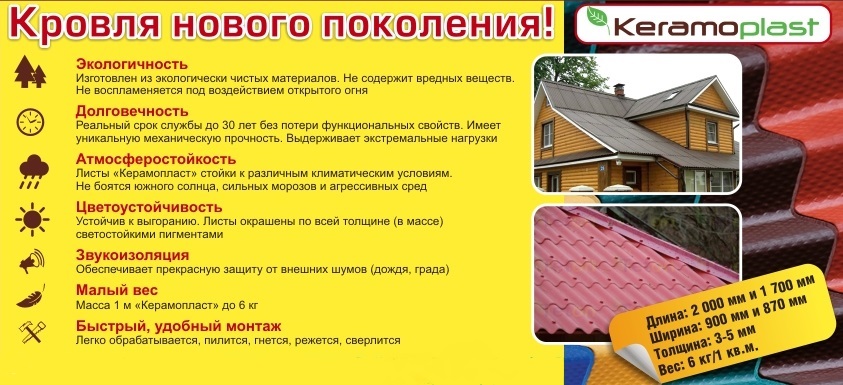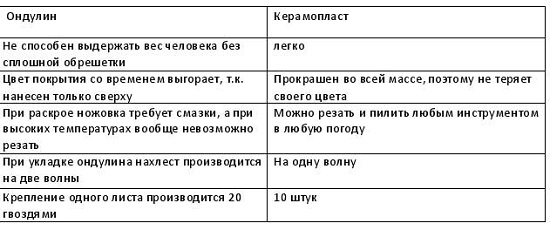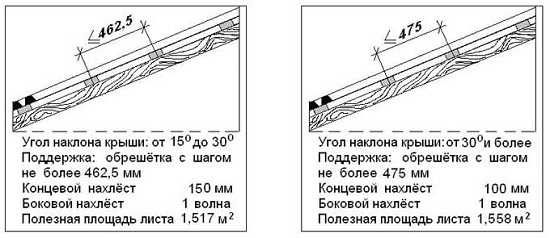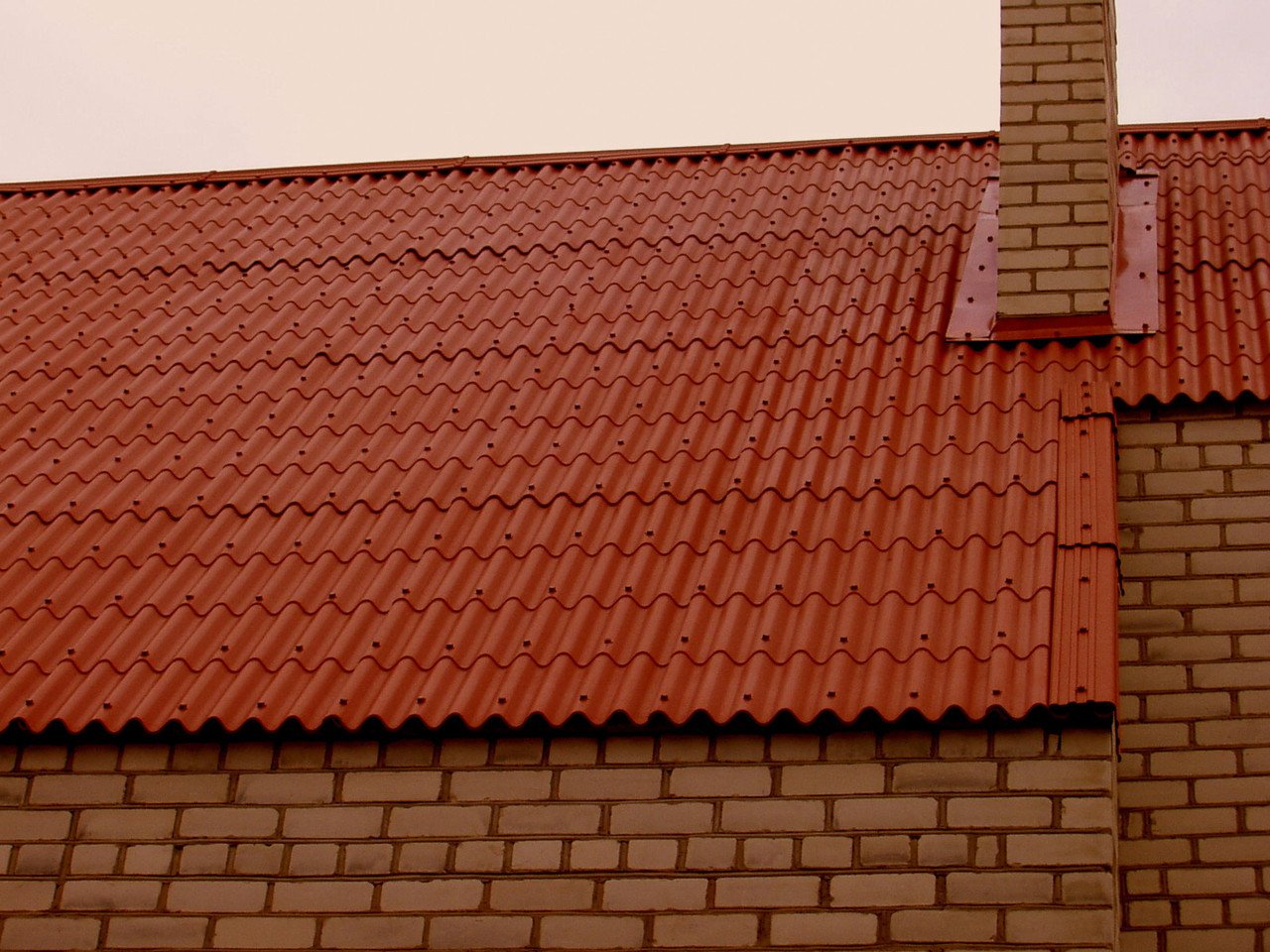Not all high-quality and popular roofing materials are developed by foreign companies. Russian factories also created a unique roof - ceramoplast. The installation instruction for this material is quite simple, and it will serve for many years.
Content
What is ceramoplast?
This is a completely new building material in the market, which is different:
- originality;
- environmental friendliness;
- rigidity and strength.
It has been produced in Russia since 2000. Today, the roof of ceramoplast is known abroad.
The material is made from natural minerals with the addition of a small amount of synthetic materials. The combination of just such components gives special advantages to such a roof. First of all, ceramic tiles have increased hardness and are very resistant to shocks of different strengths and all kinds of damage. Therefore, roofing ceramoplast reviews is very good and is used in a wide variety of areas of construction.
Ceramic Plastic Specifications
Keramoplast has a unique combination of beauty and functionality. It is used in their work not only by builders, but also architects, designers who develop a new look for interior interiors and external facades and roofs. With it, the house will look neat, prestigious and representative.

Roofing ceramoplast is available in the form of large wave sheets. Their thickness can be either 3 or 4.5 mm. The surface of the material can be perfectly smooth. Such sheets are available in size 2000 * 900 mm. If desired, you can purchase textured ceramic. The dimensions of the sheet of this option will be slightly smaller - 1700 * 870 mm.
In addition to the sheet version, there is also a ceramic tile. It can have 2 sizes:
- 500 * 900 * 4 mm;
- 560 * 870 * 4.5 mm.

Ceramoplast is always painted to its full thickness. That is why when covering the roof, this material does not fade for a very long time. And you can choose almost any shade of the future roof. Ceramoplast can be green, red, blue, gray, etc.
So, we can distinguish several important advantages of ceramoplast:
- Lack of substances harmful to health in the composition of the material. Keramoplast has a certificate of hygienic safety.
- Durability - can withstand even the most extreme weather conditions.
- Durability - lasts 30 years.
- Color fastness - burnout will never happen.
- Thermal insulation - keeps heat well.
- Soundproofing - Do not miss any sounds in the streets.
- Elasticity - when heated, a ceramic sheet can be made by anyone.
- Lightness - a square meter of material weighs only 6 kg.
- Convenient installation - quick roof assembly.
Advantages and disadvantages of ceramoplast
Having existed in the building materials market for more than 10 years, roofing ceramoplast reviews received only good ones. After all, it is waterproof, has a very high frost resistance. It will not make noise when it rains, and never builds up static electricity in itself. In addition, ceramoplast has the ability to withstand quite large loads.

To the question of which is better: ceramoplast or ondulin, many experts leave their vote precisely in favor of ceramoplast.There are several reasons for this:
- You can’t walk along Ondulin, he can simply become worthless;
- If laying takes place on a hot day, then ondulin will become too soft and it will be very difficult to work with it. Keramoplast always remains in its shape.
- It is more difficult to fix the ondulin, and much more fasteners are required for this.
How to make installation of ceramic sheets
Laying this building material is quite simple.

Working with ceramic plastics is similar to laying ordinary slate. Those. one wave lap.
Laying sheet ceramoplast is carried out exclusively on the crate, which should be made of wooden boards. They are all mounted in increments of 380 mm. In this case, the angle of the roof itself is not taken into account.

Before laying the roofing material, it would be good to impregnate all wooden elements with a special solution
Correctly calculating the required amount of roofing material is quite easy. To do this, the roof is drawn on a certain scale. Next, a cutting is carried out, in which the lateral and end overlaps should be taken into account (approximately 50-100 mm). Only in this way will it become clear how many ceramic sheets need to be bought. Experts say that this material is much more economical than other roofing options.
Porcelain sheets are mounted in two ways. Everyone is free to choose their own, the most convenient and suitable:
- With offset relative to the rows. Moreover, it occurs exactly half the sheet.

With this method of installation, it is very IMPORTANT to ensure that the joint of two sheets of ceramoplast falls exactly in the middle of the next row.
This styling method is called “zigzag”. It is convenient and attractive in that it helps to avoid overlapping four sheets at the same time.
- The standard option is a “chess order”. Those. ceramoplast sheets do not move, and an overlap of 4 thicknesses is formed.

In order to avoid excessive thickness when staggered sheets, you can trim the corners of the two middle sheets. At the same time, leave the top and bottom sheets intact.
Porcelain sheet laying tips
Ceramoplast specifications are amazing, so they can cover even too vast spaces. To do this, it is recommended to first lay the entire bottom row. Focusing on it, it will be much easier to mount the side rows. It is enough to simply lay the ceramoplast at a right angle to the first row.

Do not rush and thoroughly fasten the sheets to the crate. First you need to gain a roof with a couple of screws.
Before finally fixing all the sheets, it would be nice to carefully check the correct installation of overlaps and the roof as a whole. Only if everything is in order, it is possible to fix ceramoplast.

Fasteners must be placed in the center of the battens. To maintain this rule, it is recommended to use a specially stretched rope.

Each sheet in the bottom row is attached using 30 elements. For subsequent, you can already use 20 screws. During installation, it is worth paying special attention to the "crest" of the ceramoplast. In these places of fastening it is not necessary to pull. Otherwise, deformation of the sheet will occur if there are temperature differences. It’s best to drill a hole a few millimeters more than usual on the ridge. This will help to avoid bloating.
Having reached the junction of the roof slopes (above), you need to install a skate. It is fastened only when all the sheets are finally laid and mounted. All the ridge details of the ceramoplast are laid sequentially, interconnected with a special "lock".

If suddenly the ridge angle is more or less than necessary, you can fix it. To do this, the blowtorch heats the inner side of the fold of the roofing element. At 60 degrees, the ceramoplast bends well to the required angle.
Porcelain wind slats
To protect the space under the roof from precipitation and dirt, special wind bars, which are also made of ceramoplast, will help. They will help make the building more attractive.
Each windshield is mounted in the overlap of the previous one. In this case, one part of it is necessarily attached to the sheets, and the other to the beam. Only 6 fastening elements for each such part are enough.
Ceramoplast will be an ideal option for a subfloor in the attic. Moreover, this material has increased strength and can withstand heavy loads, including the weight of a person.
Ceramic tile
In addition to large sheets, ceramoplast is also available in the form of tiles, which looks very similar to the French roof known throughout the world. It will withstand all the vicissitudes of the weather and for many years will delight the owners of country houses, cottages, shops with its beautiful appearance.
Working with tiles is a pleasure. It is laid in the same way as ordinary ceramic sheets, and if necessary it is very easy to bend or cut. Keramoplast tile does not require any special tools for styling. Only a screwdriver, which is found in the economy of every man, is useful.

During transportation or during installation, ceramoplast can be slightly damaged. Then small white stripes will appear on it. Do not be afraid, because they are easy to destroy. It is just a little necessary to warm these areas with a blowtorch, then the defects will all go away.
Ceramoplast roofing material received excellent reviews from builders and owners of private houses. Created using a special, innovative technology, ceramoplast combines the characteristics of a synthetic and natural material. Its bright color remains throughout the entire period of operation. And any other roofing material can envy such a number of shades.
Ceramoplast greatly facilitates the entire structure of the roof. This means that the construction of a roof for a house or any other structure can significantly save.
Even an inexperienced builder will cope with the installation of sheets or tiles of ceramoplast. After all, doing this is very easy and fairly quick. The entire period of operation of anxious roof care will not be required. And if it is necessary to repair it, it will be very simple and quick.
Today, ceramoplast is a popular building material for creating a beautiful and reliable roof. And if you want the house to look stylish, beautiful and please you with its bright appearance for many years, then it is necessary to choose ceramic plastics. Indeed, in the arsenal there are a variety of colors, ranging from classic brick, gray and green tones, ending with bright fluorescent options.





Alexandr Skopich
I purchased and installed roofing material called ceramoplast "Cascade". If I had known how bad this vaunted leaf would have gone around the “tenth road”. It crumbles, bursts and does not fit due to an incomprehensible collar from the left edge of the sheet. When stacked “in a checkerboard pattern” it is still bearable, but the “zigzag” is simply complete. In the place of overlapping sheets, a gap of up to 5 mm is formed.